Reserve Bank of Australia Annual Report – 2017 Banknotes
The Reserve Bank is responsible for producing and issuing Australia's banknotes. The Bank seeks to ensure the high quality of banknotes in circulation to maintain confidence in banknotes as a payment mechanism and a store of value. The Bank also conducts research and development to ensure that Australian banknotes remain secure against counterfeiting. To this end, the Bank is issuing an upgraded series of banknotes, with the first denomination – the $5 – issued in September 2016 and the $10 to be released in September 2017. At the end of June 2017 there were 1.5 billion banknotes, worth $73.6 billion, in circulation.
The Reserve Bank is responsible for producing and issuing Australia's banknotes. Public demand for banknotes stems from the role of banknotes as both a payment mechanism and a store of value. To preserve public confidence in the capacity of banknotes to perform these roles, the Bank:
- works with its wholly owned subsidiary, Note Printing Australia Limited (NPA), to design Australia's banknotes; arranges for their production through NPA; and issues the banknotes to meet public demand
- maintains the quality of banknotes in circulation by withdrawing old, worn banknotes and replacing them with new banknotes
- conducts research and development to ensure that Australian banknotes remain secure against counterfeiting.
Next Generation Banknote Program
The Next Generation Banknote program was established in 2007 to ensure Australia's banknotes continue to be secure against counterfeiting. It will result in an upgraded series of banknotes with a range of innovative security features that have not previously been used on Australian banknotes.
The release of the upgraded series is occurring over a number of years. The first denomination in the new series, the $5 banknote, was issued from 1 September 2016. The design of the new $10 banknote was revealed in February 2017 and it will enter circulation from 20 September 2017. This will be followed by the $50, which is expected to enter circulation in late 2018. The remaining denominations will be introduced in subsequent years.
The new banknotes will retain many of the key design elements of the current banknote series, including the people portrayed, their size and their colour palette. There are, however, design changes that have been made to accommodate the new security features. The new banknotes include a top-to-bottom clear window and each displays a different species of Australian wattle and native bird within a number of the security features.
An integral element of the new banknote program has been the Reserve Bank's consultation with key stakeholders to ensure that the new banknotes continue to meet the needs of the community. This includes supporting the broader banknote industry and high volume cash handlers during the transition to the new banknote series. The Bank continues to engage with manufacturers, deployers and owners of banknote processing equipment, and provides them with access to test material to develop and confirm equipment solutions well ahead of the new banknotes being issued. The Bank has a communication strategy to ensure that the public is well informed about the new banknotes and can readily identify the new security features.
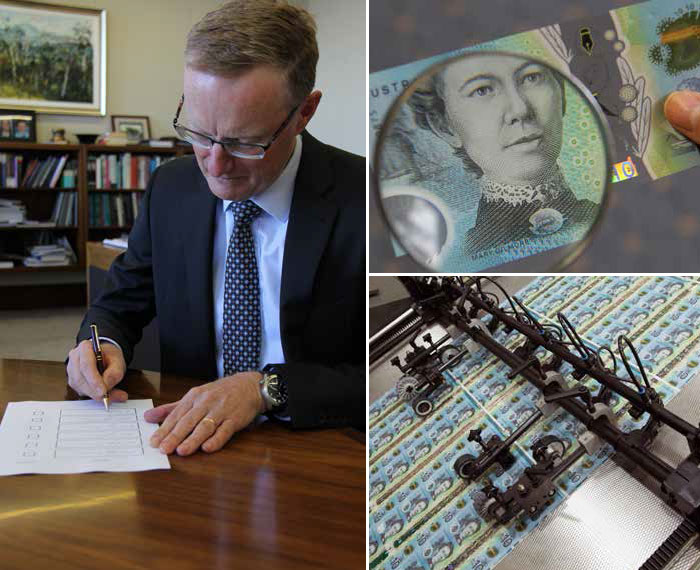

For the $5 banknote, this included an extensive advertising campaign in regional newspapers and television, as well as on radio and online, with material also translated into other languages. A promotional video that illustrates the dynamic nature of the new security features has been viewed more than 1 million times.
As part of the Reserve Bank's public awareness campaign, the Bank launched a mobile app, ‘RBA Banknotes’. The app provides an interactive tool that enables users to learn about banknote design and security features on all current Australian banknotes, including the new $5 and $10, as well as how to handle counterfeit and damaged banknotes.
The time and cost of the Next Generation Banknote program is budgeted at $37 million for all five denominations. To date, $29.8 million of this has been spent on the process of designing and testing the new banknote series, as well as the extensive community consultation, communication and education initiatives.
Banknote Accessibility
From the outset of the current program to upgrade the banknotes, it was decided that the existing accessibility characteristics of Australia's banknotes – their size differentials, vibrant colours and bold, contrasting numerals – would be retained to ensure that Australia's banknotes are accessible for people with impaired vision.
The new series of banknotes also includes a tactile feature, which was developed in consultation with the vision-impaired community to provide a feature directly on the banknote that is durable, simple and readily usable. The new $5 banknote has a raised bump on each of its long edges next to the top-to-bottom window. Subsequent denominations will have increasing numbers of raised bumps in a similar location.
Community Liaison
The Reserve Bank actively engages with a range of interested parties, including users and manufacturers of banknote equipment, law enforcement agencies, retail organisations, schools and financial institutions, with the aim to increase community knowledge about banknotes. More than 145 banknote-related presentations were given by Bank staff during 2016/17. The majority of these presentations were delivered to visitors to the Reserve Bank of Australia Museum.
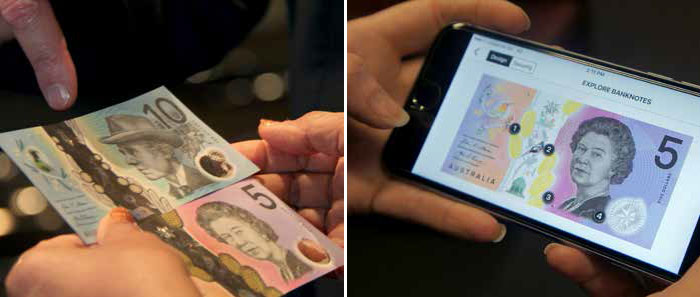
As noted above, the Reserve Bank has continued to provide information about the new banknote series to the public in a variety of ways. One area of focus has been retailers and commercial banks to ensure that their staff are trained and ready for customer enquiries. Bank staff have attended a number of industry events and delivered presentations to high-volume cash handling groups to share information about how to use the security features of the new banknotes.
Banknote Infrastructure Modernisation Program
In preparation for the logistical demands arising from the introduction of the new banknote series, the Reserve Bank is well advanced in a program to upgrade its existing banknote infrastructure. The main objectives of the upgrade are to increase banknote storage and processing capacity, and to introduce new technologies and systems to improve banknote logistics processes and simplify distribution arrangements.
The upgrade involves construction of the National Banknote Site (NBS) in Craigieburn, Victoria. Construction of the new two-storey building was completed in early 2017 and, following the commissioning of the automatic processes, it is scheduled to be fully operational by early 2018.
Banknote Research and Development
The Reserve Bank maintains an active research and development (R&D) program focused on the development of innovative security features and detection technologies for Australian banknotes. The primary aim of this program is to ensure that Australian banknotes remain highly secure against counterfeiting and easy to authenticate for a wide variety of users. A core function of the R&D program is research into new and emerging technologies that can be developed into future generations of security features and detection equipment for banknotes. This is achieved in part through collaboration with domestic and international experts from various external organisations, including universities, public and private companies, research institutes and other central banks. Fundamental to this program is a continuing assessment of the vulnerability of banknotes to different forms of counterfeiting, the mechanisms by which banknotes wear in circulation, and how the public and banknote processing machines use and authenticate banknotes.
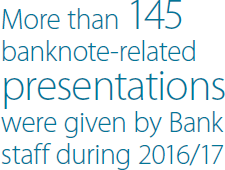
In addition to these activities, the Reserve Bank contributes to several international forums associated with various aspects of banknote security. These include: the Central Bank Counterfeit Deterrence Group, which examines emerging threats in counterfeiting technologies; the Reproduction Research Centre, which provides facilities to test new security features; and the Four Nations Counterfeit Deterrence Working Group, which is a group of central banks that collaborate on the development of technologies to reduce counterfeiting threats. The Bank also works closely with its partners and suppliers to incorporate new technologies and features into the banknote production process.

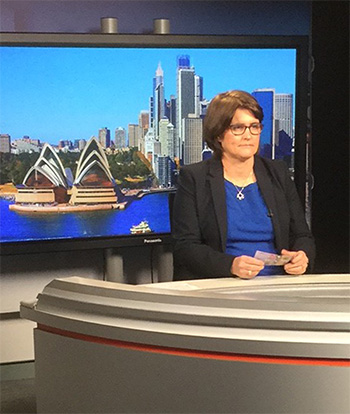
In 2016/17, the research program continued to focus on providing technical advice and expertise as part of the development of the new series of Australian banknotes by conducting trials, assessing new technologies and strategies to ensure the durability of the new security features, and developing instrumentation for banknote examination. This was done in conjunction with the development of new testing methodologies that will form part of the Reserve Bank's ongoing quality assurance program.
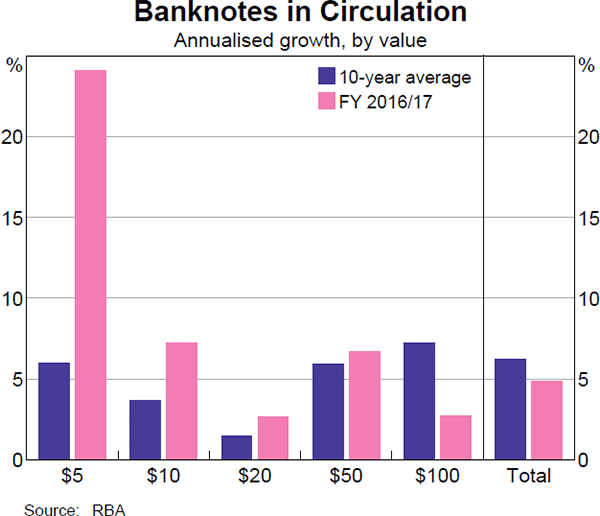
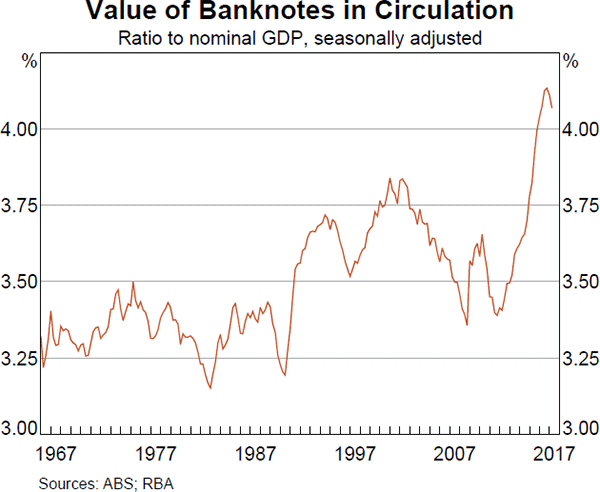
Banknotes on Issue
The value of banknotes in circulation increased by 5 per cent in 2016/17, slightly below its long-term average growth rate of 6 per cent, reflecting below-average growth in the $100 denomination. By contrast, the value of low-denomination banknotes increased relatively strongly, particularly in the case of the $5 banknote, but these account for only 1.4 per cent of the value of banknotes in circulation. At the end of June 2017, there were 1.5 billion banknotes, worth $73.6 billion, or around 4 per cent of nominal GDP, in circulation. The ratio of the value of banknotes in circulation to nominal GDP remains at an historically high level.
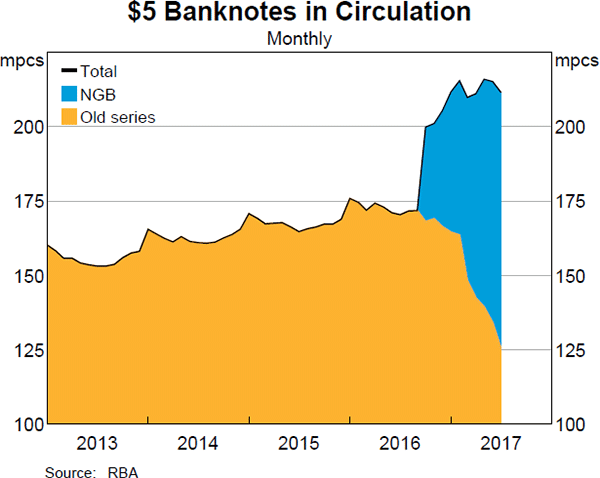
The marked increase in the number of $5 banknotes in circulation over 2016/17 was a result of the release of the new $5 banknote in September 2016. As at the end of June 2017, 86.5 million new $5 banknotes had been issued by the Reserve Bank while only 46.7 million banknotes from the previous series had been returned.
Distribution
The Reserve Bank maintains banknote holdings to accommodate growth in the number of banknotes in circulation, for seasonal fluctuations in demand and for contingency purposes in the event of systemic shocks and production disruptions. The Bank has established distribution agreements with a number of commercial banks, which provide the banks with access to banknotes. The Bank issued banknotes worth $9.0 billion in 2016/17, of which $3.6 billion had been in circulation previously and $5.4 billion were new.
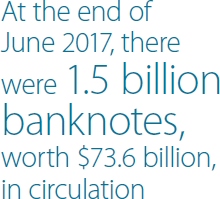
The Reserve Bank aims to maintain a high quality of banknotes in circulation to ensure public confidence in their suitability as a payment mechanism and store of value. High-quality banknotes are more readily handled by machines and make it more difficult for counterfeits to be passed. For this reason, the Bank has arrangements that encourage the commercial banks and the cash-in-transit companies to continue to distribute banknotes that remain fit for circulation and return those that are unfit to the Bank's processing site in Craigieburn. These unfit (damaged) banknotes are assessed using high-speed processing machines to confirm their authenticity and quality. In 2016/17, the Bank received $2.0 billion worth of banknotes, of which $1.9 billion worth was deemed to be unfit for recirculation.
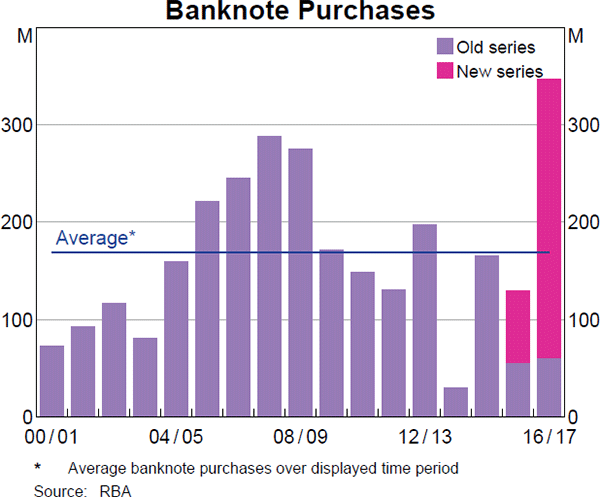
The Reserve Bank also provides an additional service through its Damaged Banknotes Facility. The facility is offered to members of the public who have unwittingly come into possession of damaged banknotes or whose banknotes are accidentally damaged, with the aim to ensure that they do not face financial hardship. Claims that meet the requirements set out in the Bank's Damaged Banknotes Policy are paid based on their assessed value. The Bank processed 15,378 claims and made $5.3 million in payments in 2016/17.
Counterfeiting Rates
Australia's level of counterfeiting remains low by international standards. In 2016/17, around 25,500 counterfeits, with a nominal value of nearly $1.5 million, were detected in circulation. This corresponds to around 17 counterfeits detected per million genuine banknotes in circulation, a 26 per cent reduction from 2015/16.
| $5 | $10 | $20 | $50 | $100 | Total | |
|---|---|---|---|---|---|---|
| Number | 29 | 91 | 320 | 20,749 | 4,302 | 25,491 |
| Nominal value ($) | 145 | 910 | 6,400 | 1,037,450 | 430,200 | 1,475,105 |
| Parts per million | 0.1 | 0.7 | 1.9 | 30.8 | 12.8 | 16.9 |
|
(a) Figures are preliminary and subject to upward revision due to lags in counterfeit submissions to the Reserve Bank Source: RBA |
||||||
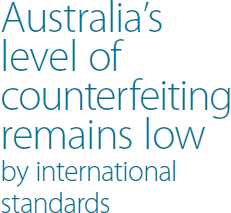
To combat counterfeiting in Australia, the Reserve Bank works closely with law enforcement agencies in Australia and overseas to monitor trends and identify emerging threats. As part of this arrangement, the Bank provides analytical and counterfeit examination services and prepares expert witness statements and court testimonies to assist the agencies with their investigations.
In 2016/17, the Australian Federal Police made a number of arrests, including one in connection with a major source of counterfeit banknotes. During the year, the Commonwealth Department of Public Prosecutions prosecuted 27 matters involving possession, uttering and making of counterfeit currency.
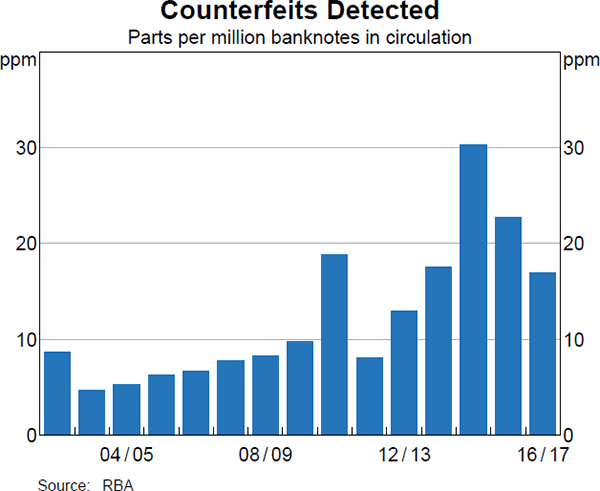
Note Printing Australia Limited (NPA)
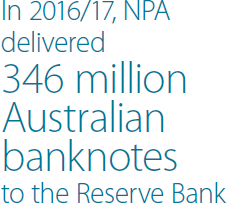
NPA is a wholly owned subsidiary of the Reserve Bank that produces banknotes and supplies other related services to the Bank and some other entities. In 2016/17, NPA delivered 346 million Australian banknotes to the Bank, comprising 118 million new series $5 banknotes, 168 million new series $10 banknotes and 60 million existing series $100 banknotes. This compared with 129 million Australian banknotes delivered to the Bank by NPA in 2015/16. NPA also provided banknote distribution and banknote processing services to the Bank until 16 February 2017, when the Bank resumed responsibility for the processing operations. The aggregate amount paid by the Bank to NPA in 2016/17 for the supply of banknotes and related services was $99.9 million.
In addition, NPA delivered 107.5 million banknotes under contract to Singapore, Papua New Guinea and Brunei in 2016/17, dealing directly with the respective central banks in those countries. NPA also produced 1.9 million P- series passports for Australia's Department of Foreign Affairs and Trade.